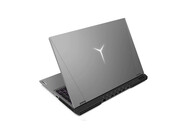Lenovo Legion 5 Pro 16ITH6H, i7-11800H RTX 3050
Especificaciones de Portátil(es)

Price comparison
Promedio de 1 puntuaciones (de 2 análisis)
Análisis para el Lenovo Legion 5 Pro 16ITH6H, i7-11800H RTX 3050
Origen: Gadgets Now
 EN→ES Archive.org version
EN→ES Archive.org versionThe Lenovo Legion 5 has a lot going for it but there are a few drawbacks that we noticed like the Wi-Fi signal would drop significantly with a little increase of the distance from the router; the rear Type-C port supports Thunderbolt, but we were unable to get an external monitor to work with our model. For the price, it sports a good build but we would have liked it to have a bigger trackpad and an aluminium chassis; and a rather mediocre speaker setup. Overall, the laptop brings a good package to the table but at a higher price. Lenovo’s Legion 5 arsenal also has AMD Ryzen offerings which perform better while not being that heavy on the wallet. Hence, we think that this can be a good gaming laptop to grab during a deal.
Único Análisis, disponible online, corto, Fecha: 12/28/2021
Puntuación: Puntuación total: 70%
Origen: Lon.TV
 Archive.org version
Archive.org versionÚnico Análisis, disponible online, Muy largo, Fecha: 12/05/2021
Comentario
NVIDIA GeForce RTX 3050 4GB Laptop GPU: Tarjeta gráfica de gama media para portátiles de juegos basada en el chip Ampere GA107. Ofrece 2048 sombreadores y se ofrece en diferentes variantes TGP (consumo de energía) de 35 a 80 vatios con diferentes velocidades de reloj y, por tanto, rendimiento. Variante más antigua con 4 GB de VRAM.
Estas tarjetas también deben ser capaces de aguantar todos los juegos actuales, pero la mayoría de ellos en configuraciones de detalles medios y bajos y con bajas resoluciones. Juegos más antiguos, o menos exigentes todavía pueden ser jugados con buena calidad de gráficos.
>> Más información puede ser encontrada en nuestra comparación de tarjetas gráficas moviles y la lista de benchmarks.
i7-11800H:
SoC octa-core de gama alta basado en Tiger Lake (serie H45) para portátiles de juegos y estaciones de trabajo. Los ocho núcleos de la CPU funcionan a entre 2,3 GHz y 4,6 GHz. La GPU UHD Graphics integrada ofrece 32 UE a un máximo de 1,45 GHz. El chip está fabricado en el proceso Intel SuperFin de segunda generación de 10 nm.
>> Más información puede ser encontrada en nuestra comparación de procesadores móviles.




